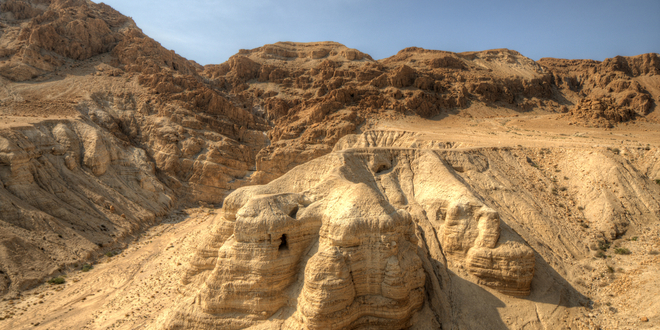Based on new studies, researchers have confirmed that the ancient site of Qumran, location of the Dead Sea Scrolls, was likely the home of the Essenes, an all-male celibate Jewish sect in the Second Temple Era.
Until now, the subject was a matter of debate, as scientists had identified both male and female skeletons in the site’s cemetery. But research done on 33 newly excavated skeletons from Qumran has revealed that almost all were male, with the genders of three skeletons indeterminate. The researchers also reexamined 53 previously unearthed skeletons from Qumran’s cemetery and discovered that six of seven individuals formerly tagged as women were actually men.
Researcher Yossi Nagar, an anthropologist for the Israel Antiquities Authority (IAA), reported last week that the most probable explanation for the lopsided demographics is that Qumran was a community of Essenes: a Jewish sect that lived a monastic life in the desert, adopting strict dietary laws and a commitment to celibacy.
Some theologians have speculated that Jesus, the founder of Christianity, was an Essene, adopting the sect’s asceticism and celibacy. Rabbi Daniel Sperber, a professor of Talmud at Bar Ilan University, discounted this theory.
“There are so many concepts about Jesus and so little known about him,” Rabbi Sperber told Breaking Israel News. “In any case, it is unlikely he was an Essene.”

The Essenes were contemporary with other Jewish sects such as the Pharisees and Sadducees. Nagar compared them to Christian monks. Though they came several centuries after the settlement in Qumran and the destruction of the Temple, the lifestyles of the Qumran Essenes and Byzantine monks that came to the region later were almost identical.
“The Jewish Essenes were monkish and dedicated to a celibate way of life,” Rabbi Sperber told Breaking Israel News. “They had a scriptorium, as did monasteries, and were prolific producers of sacred texts.”
He pointed out that at the time, Judaism was very diverse. “Most people think of Judaism as what we have today from the Mishna and Talmud (the two components of the oral tradition), but that is only one stream that existed at that time,” Rabbi Sperber said, noting that at the time of the Essenes, other sects such as the Sadducees and Pharisees were choosing vastly different paths in Judaism.
Observant Jews today may be perplexed at this aspect of the archaeological find. Celibacy is rejected as a sin in Judaism, and Jewish law considers procreation to be the first mitzvah (Bible commandment).
Hashem blessed them and Hashem said to them, “Be fertile and increase, fill the earth and master it; and rule the fish of the sea, the birds of the sky, and all the living things that creep on earth.” Genesis 1:28
“The Essenes decided on an ascetic lifestyle in order to concentrate on Torah study and serving Hashem,” explained Rabbi Sperber, noting that there were precedents of prominent spiritual figures in Judaism who chose celibacy, including the Prophet Jeremiah.
You are not to marry and not to have sons and daughters in this place. Jeremiah 16:2
“Despite their celibate lifestyle, the Essenes were Jews in every manner and considered by their contemporaries to be so,” Rabbi Sperber said. “Though they may be thought of as outside Judaism today, the Essenes were one of the major sects of Judaism at the time.”
Titus Flavius Josephus, a first-century Romano-Jewish historian, described the ascetic life of the Essenes as deeply communal and anti-materialistic. “Since [they are] despisers of wealth — their communal stock is astonishing — one cannot find a person among them who has more in terms of possession… the assets of each one have been mixed in together, as if they were brothers, to create one fund for all.”
Josephus also noted that a separate order of Essenes differed on the matter of celibacy. “Though agreeing with the others about regimen and customs and legal matters, it has separated in its opinion about marriage,” he wrote. “For they hold that those who do not marry cut off the greatest part of life, the succession, and more: if all were to think the same way, the line would very quickly die out.”

C-14 radiocarbon test indicates that the Qumran skeletons are around 2,200 years old, approximately the same age as the Dead Sea Scrolls also found at the site, which were estimated to have been written between 150 BCE and 70 CE, the year the Second Temple in Jerusalem was destroyed.
Earlier investigations of Qumran suggested it was founded more than 2,700 years ago. Warfare led to its abandonment before it was settled again for about 200 years, up to around the year 68 CE. The Dead Sea Scrolls, manuscripts that included parts of the Bible, were discovered between 1947 and 1956 in 11 caves in the region surrounding Qumran.
In February, researchers announced they had found an additional cave in the same area that held blank scrolls and pieces of papyrus and leather intended to be written on, consistent with what would be found in a scriptorium.
The post Dead Sea Scrolls Written by Celibate Jewish Essene “Monks”, Qumran Skeletons Confirm appeared first on Breaking Israel News | Latest News. Biblical Perspective..
Source: Israel in the News

